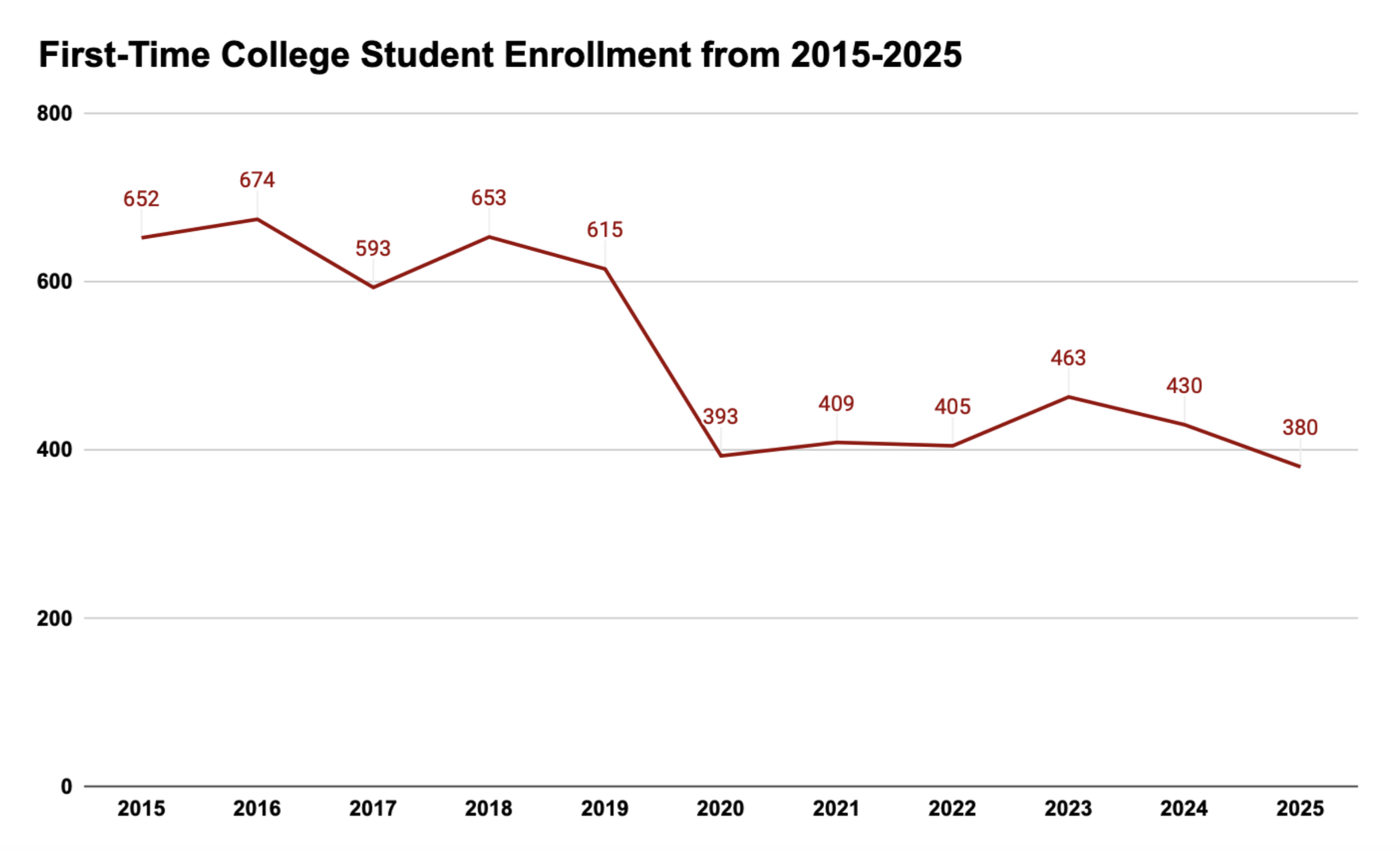
President Isiaah Crawford shared with the campus community at the end of the previous academic year that enrollment for the 2025 incoming class was “falling short of our initial goal.” Enrollment for the class of 2029 was lower than last year, following a downward trend that began in 2018 and saw its largest drop in 2020 at the beginning of the COVID-19 pandemic. This year, 380 first-time college students enrolled, which is 50 students fewer and 12% smaller than last year’s incoming class. A decade ago, enrollment for first-time college students was 652 students — significantly larger than this incoming class. Students and members of the University administration weighed in on the causes and consequences of this enrollment trend, as well as a plan for the University’s future direction.
A major reason that the University has been seeing lower enrollment rates is due to a phenomenon called “the demographic cliff,” which Dean of Students Sarah Comstock and President Crawford both discussed. “During the recession in 2007-2009, people had fewer kids, and because there were fewer kids born eighteen years ago, we now have fewer students coming into colleges nationally for the next few years,” Comstock said regarding the demographic cliff.
To try to regain higher student enrollment rates and combat the effects of the demographic cliff, the Office of Admissions is adopting some new strategies. “One of my primary charges was the development of a new/refreshed Strategic Enrollment Plan (SEP) designed to identify and respond to the challenges and trends of today’s college recruitment landscape, and support the goals within our institutional strategic plan, Leadership for a Changing World,” said Vice President of Enrollment Tim Whittum. He also said his office aims to refine its communication and marketing strategies. These new strategies have already proven to be successful, Whittum said, as demonstrated by the high participation in this September’s Discover Puget Sound Open House, in which 130 prospective students and their families participated. “It was the largest September open house ever, and [there] was an increase in student attendance of 67% compared to the same event last fall.” These bolder strategies are reflected in the words of President Crawford: “We’re going to be more scrappy to get the word out about us.”
Enrollment challenges have contributed to the University’s financial troubles. The 2025-2026 Budget Task Force (BTF) Report estimates that 78% of the University’s budget will come from tuition and fees this year. Decreased enrollment has partially caused the University to fall into a deficit, and the Budget Task Force is developing a plan to return to “financial equilibrium.”
Despite the economic challenges resulting from low enrollment, President Crawford said the student experience won’t change dramatically. “We’ve made necessary expense reductions across the University where we could, but we’ve been doing that in a way that we believe does not undermine the quality of the educational experience that we’re able to provide students,” he said.
The expense reductions primarily affect faculty, according to both Crawford and Comstock. “Rather than significant layoffs that are being seen at other institutions, we’ve been thoughtful about utilizing retirements and elimination of some vacant positions,” said Comstock.
Students learning about these reductions had a different perspective and believe that faculty changes affect student life more than predicted. Eli Pockell-Wilson (‘26) offered his own perspective on shifts he is seeing in his economics major due to staffing changes. “It’s hard at a liberal arts university when you’re supposed to have access to faculty and they’re so busy,” he said.
The 2025-2026 BTF Report indicated that the University aims to increase revenue by renting spaces for conferences and events. It estimates that those auxiliary operations will bring in $700,000 this year. Bringing more events to campus will help reduce the deficit, and Crawford hopes they will be well-attended by students and faculty. He emphasized the importance of these events as a component of the University’s strategic plan’s fifth goal: diversifying revenue. Additionally, the events are designed to bring the community together. Administration is excited about these events and some students are mirroring these feelings. Turtle Steele (‘29) commented that they think more outside organizations coming to campus will benefit students. “I think that could be a good thing. More organizations, more people, more perspectives!”, they shared.
Overall, the administration is hopeful for the future of the University. Comstock said that she foresees an increase in enrollment in the future and noted progress in student retention. “When we talk about enrollment, it isn’t just the influx of new students in the fall; it is also the retention of returning students. This year, our fall-to-fall retention is 88%, 4% higher than it was last year, and a full 8% higher than it was three years ago.” Students have mixed views on what they believe the future of enrollment will look like. Pockell-Wilson sees tuition increases as a potential deterrent to prospective students. “If the tuition cost is more, then people will probably be dissuaded from coming here,” he said. In contrast, Steele thinks the downward trend in enrollment will dissipate if the national political leadership becomes less hostile to higher education. “I think it will soon blow over, and then it should start increasing again,” they commented.
President Crawford wants to look to students to be part of the solution. “If your readership has ideas for us around other things that we might want to look to address, adjust or do, to help support our student recruitment efforts (because in some respects, you’re the true experts), we would be really, really open to your input,” he said.
